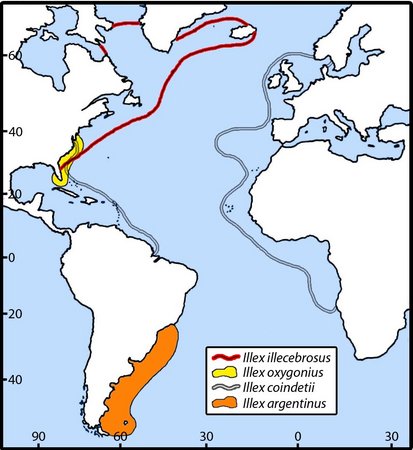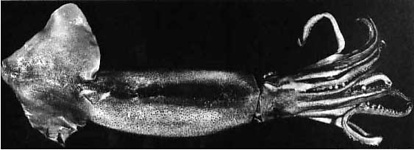Illex illecebrosus
Michael Vecchione and Richard E. YoungIntroduction
I. illecebrosus. the northern shortfin squid, is probably the most abundant cephalopod in the western North Atlantic, and is the target of an intensive fishery off northeastern North America. It is also very important as both predator and prey in the continental shelf and slope ecosystems of that area.Characteristics
- Arms
- Hectocotylus (either left or right arm IV)
- Hectocotylus shorter than or equal to its opposite arm in length, always equal in thickness.
- Distal portion (HA3) of arm IV 13%-30% of total arm length with weakly developed papillae and lamellae.
- Basal portion (HAb) short, about 6% of total arm length.
- Proximal portion (HA1) with 7 to 8 pairs of normal suckers increasing in size distally.
- Middle portion (HA2) with suckers about 3/4 diameter of proximal suckers; oral surface of arm not expanded; sucker rows not abnormally separated; very slight constriction between HA1 and HA2; trabeculae not modified as fringed lobes.
- Hectocotylus shorter than or equal to its opposite arm in length, always equal in thickness.
- Hectocotylus (either left or right arm IV)
- Tentacles
- Largest distal medial manal sucker-rings smooth, without crenulations or notches.
- Largest distal medial manal sucker-rings smooth, without crenulations or notches.
- Head
- Head-width index low, 16.3-17.0.
- Beaks: Descriptions can be found here: Lower beak; upper beak.
- Head-width index low, 16.3-17.0.
- Fins
- Fin angle usually 45° (40°-50°), never > 50°.
- Fin angle usually 45° (40°-50°), never > 50°.
- Reproductive structures
- Spermatophore: "Spermatophore cone at oral end of cement body, a low, right-isosceles triangle with rounded corners in outline; oral tube long, narrow; aboral neck long, narrow" (Roper, et al., 1998).
Life History
I. illecebrosus inhabits inshore waters in summer and retreats to deeper, offshore waters of the continental shelf and slope in autumn and winter. It occurs in temperatures of 0° to 15°C, optimum 7° to 13°C, so it is restricted to northern waters. Spawning grounds and season are unknown, but recent data indicate a late autumn-early winter spawning in offshore slope water near the inshore edge of the Gulf Stream. An inshore summer migration is associated with intensive feeding, primarily on small fishes and euphausiids.Distribution
Type locality - Northwest Atlantic near the Isles of Shoals, New Hampshire, United States, at approximately 43°N, 70°30'W.
Geographical distribution - Western North Atlantic from 66°N, and Baffin Island, to about 29°N in the Straits of Florida. Records apparently of I. illecebrosus exist from Iceland, southern Greenland and the Mid-Atlantic Ridge but these may be strays from the normal habitat (Roper et al., 1998).


Figure. Distribution chart of all four species of Illex; modified from Roper et al. (1998).
Vertical distribution - I. illecebrosus is primarily a neritic species of the continental shelf and upper slope. Its vertical range is extensive depending on size, season, and time of day. It has been caught from the surface to about 1 000 m depth; but tends to congregate on or near the bottom during the day and disperse into the water column at night.
Title Illustrations

| Scientific Name | Illex illecebrosus |
|---|---|
| Specimen Condition | Live Specimen |
| View | Dorsal |
| Image Use |
 This media file is licensed under the Creative Commons Attribution-NonCommercial License - Version 3.0. This media file is licensed under the Creative Commons Attribution-NonCommercial License - Version 3.0.
|
| Copyright |
©

|
About This Page

National Museum of Natural History, Washington, D. C. , USA

University of Hawaii, Honolulu, HI, USA
Page copyright © 2018 and
 Page: Tree of Life
Illex illecebrosus .
Authored by
Michael Vecchione and Richard E. Young.
The TEXT of this page is licensed under the
Creative Commons Attribution-NonCommercial License - Version 3.0. Note that images and other media
featured on this page are each governed by their own license, and they may or may not be available
for reuse. Click on an image or a media link to access the media data window, which provides the
relevant licensing information. For the general terms and conditions of ToL material reuse and
redistribution, please see the Tree of Life Copyright
Policies.
Page: Tree of Life
Illex illecebrosus .
Authored by
Michael Vecchione and Richard E. Young.
The TEXT of this page is licensed under the
Creative Commons Attribution-NonCommercial License - Version 3.0. Note that images and other media
featured on this page are each governed by their own license, and they may or may not be available
for reuse. Click on an image or a media link to access the media data window, which provides the
relevant licensing information. For the general terms and conditions of ToL material reuse and
redistribution, please see the Tree of Life Copyright
Policies.
- First online 13 January 2011
- Content changed 20 February 2018
Citing this page:
Vecchione, Michael and Richard E. Young. 2018. Illex illecebrosus . Version 20 February 2018 (under construction). http://tolweb.org/Illex_illecebrosus/77445/2018.02.20 in The Tree of Life Web Project, http://tolweb.org/














 Go to quick links
Go to quick search
Go to navigation for this section of the ToL site
Go to detailed links for the ToL site
Go to quick links
Go to quick search
Go to navigation for this section of the ToL site
Go to detailed links for the ToL site